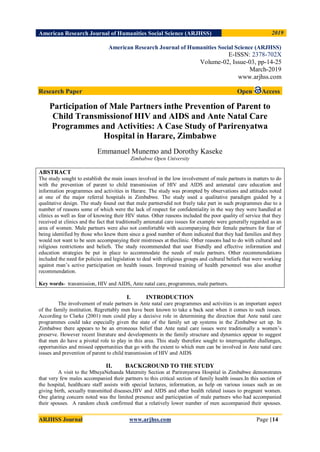The study investigates the low participation of male partners in HIV/AIDS prevention and antenatal care programs in Harare, Zimbabwe, focusing on barriers such as confidentiality concerns, cultural beliefs, and the perception of antenatal care as a women's issue. Recommendations include implementing user-friendly education strategies and policies to address cultural and religious barriers, as well as improving training for health personnel. Enhanced male involvement is crucial for improving health outcomes and reducing mother-to-child transmission rates of HIV.










![American Research Journal of Humanities Social Science (ARJHSS)R) 2019
ARJHSS Journal www.arjhss.com Page |24
Male partners need to be more flexible in the way they respond to issues to do with ante natal care and
prevention of parent to child transmission programmes
Government needs to come up with stringent laws and policies to guide especially religious groupings
that are bent on misinforming society thereby misleading communities into serious health challenges.
All avenues of information disserminationshould be exploited in-order to facilitate informed attitudes on
issues to do with ante natal care and prevention of parent to child transmission of HIV and AIDS
concerns.
III. CONCLUSION
The study came up with a number of themes namely low male involvement in antenatal care and
prevention of parent to child transmission programmes, the fear of knowing one‟s status, lack of information or
limited information, the view that antenatal care and prevention of HIV and AIDS were meant for women only,
lack of respect to confidentiality concerns at clinics, religious and cultural beliefs , clinic opening hours and the
general quality of service as well as the need to consult clients on their needs. The study was able to expose
some of the challenges that have bedeviled the participation of man in antenatal care and prevention of parent to
child transmission of HIV and AIDS. These include lack of or limited information strategies, fear of knowing
one‟s HIV status, the absence of confidentiality at the clinics, poor quality of service, erroneous cultural beliefs,
religious beliefs that were not user friendly and hours of doing business used the clinics. Possible explanations
for what could have been the source of the challenges were explored as well. Recommendations that could assist
in addressing some of these challenges were also proffered.
REFERENCES
[1]. Aarnio,A.,Olsson,P,Chimbiri,A.andKulamala,T(2009):MaleInvolvementinAntenatalHIVCounselingan
dTesting:Exploringmen‟sperceptionsinruralMalawi.In:AIDSCare,21(12)1546-1576.
[2]. Adera, A,Wudu,M., Yimam,Y. ,Kidane, M., Woreta, A., &Molla,T. (2015). Assessment of
MalePartner‟s Involvement in Prevention of Mother-to-Child Transmission of HIV and Associated
FactorsAmong Males in PMTCT Services. American Journal of Health Research, 3, (4), 221-231.
[3]. Best,J.W.& Khan, V. 1993 Research in Education.London.Allyn 7 Bacon PublishersBorg,W.R.&Gall,
M.D. 1996Eduaction Research.An Introduction.New York
[4]. Burns,N.andGrove,S.K.(2005):The practice ofnursingresearch:conduct,critiqueand utilization.
Missouri: Elsevier
[5]. Chandisarewa, W, Sranix-Chibanda, L, Chirapa, E, Miller, A, Simoyi,M,Mahomva, A(2007) Routine
offer of antenatal HIVtesting: opt-outapproachtopreventmother-to-children‟smission ofHIV in
urbanZimbabwe.In: Bulletin of theWorld Health Organization, (85)843-850.
[6]. Clarke, S,(2001):Includingmen in reproductivehealth.AIDS Link (63):13
[7]. Haile, F., &Brhan, Y. (2014) Male partner involvements in PMTCT: a cross sectional study, Mekelle,
[8]. Kang‟oma G. (2011). Exploring factors affecting men‟s involvement in Prevention of Mother to Child
Transmission of HIV programme at Nkhoma Mission Hospital in Lilongwe. Open Journal of reventive
Medicine, 1(2), 35-42. doi.org/10.4236/ojpm.2012.21006
[9]. Kasenga,F,Hurtig,A.KandEmmelin,M (2007):HIVpositivewomen‟sexperiencesofa
preventionofmother-to-childtransmissionprogrammeinruralMalawi.In: Midwifery,26(1)27-37.
[10]. Katz,A.D,Kiarie,J.N, John-Stewart,G.C,Richardson,B.A, John,F.NandFarquhar,C(2009):
MalePerspectives on Incorporating Men into Antenatal HIV Counseling and Testing. In: Journal of
Acquired ImmuneDeficiencySyndrome, 4 (11).
[11]. Kunene, B, Beksinska, M, Zondi, S, Mthembu, N, Mullick, S and Ottolenghi, E (2004):
InvolvingMeninMaternity Care:A USAID study.Availableat:
http://www.popcouncil.org/pdfs/frontiers/FR_FinalReports/SA_mim.pdf(Accessed1304/2013:23:00).
[12]. Madzima,B,Nyamayaro,WandChadambuka,A(2009):Asurveyonlowmale involvement in
ANC/PMTCTprogrammeinZvimbaDistrict:DepartmentofCommunityMedicine,University
ofZimbabwe, Harare.
[13]. Mlay,R,Lugina,HandBecker,S(2008):CouplecounselingandtestingforHIVatantenatalclinic: Views from
men,womenand counselors.In: AIDS Care, 20 (8)356-360.
[14]. Morfaw, F., Mbuagbaw, L., Thabane, L., Nana, P.& Rodrigues, C., (2013). Male participation
inprevention programs of mother to child transmission of HIV: A systematic review to identify
barriers.
[15]. BioMedicalCentral, 2 (5), 6. doi: 10.1186/2046-4053-2—5. Musheke,
[16]. MinistryofHealthandChildWelfare(2007)Preventionofmother-to-
children‟smissionofHIV,ZimbabweAnnualreport, 2006
[17]. NationalAIDSCouncil,Zimbabwe (2004):NationalHIV/AIDScommunicationstrategy2005. Harare:](https://image.slidesharecdn.com/b231425-191010100346/85/B231425-11-320.jpg)
![American Research Journal of Humanities Social Science (ARJHSS)R) 2019
ARJHSS Journal www.arjhss.com Page |25
NAC.
[18]. Nkuoh, G.N,Meyer,D.J,Tih,P.MandNkfusai,J(2010):BarrierstoMen‟sParticipation in
AntenatalandPreventionsofMother-to-Child HIVTransmissionCare in Cameroon.In:Journal of
MidwiferyandWomen‟s Health, 55 (4)363-369.
[19]. PopulationCouncil(2005):Maternalandchildhealth:Mixedsuccessinvolving
meninmaternalcareworldwide.PopulationBriefs11(1) Populationcouncilwebsite:
www.popcouncil.org/publications/popbriefs/pb11(1)_1.html(Accessed on04/09/2017: 08:49).
[20]. Parent to ChildTransmissionof HIV & AIDS inZimbabwe (2010)Proceduresand LogisticsManual-
PracticalPolicy Guidelineson
implementingandmanagingPMTCTprogrammesforhealthserviceproviders:MOHCWTBand AIDS
UNIT.
[21]. Rutenberg,N,Kabibala,S,Mwai,CandRosen, J(2003):IntegratingHIVpreventionandcare into
maternalandchildhealthcaresettings:lessonslearnedfromHorizonsstudies,July23-27,2001.
[22]. Said, M. (2014). Factors influencing Prevention of Mother to Child Transmission (PMTCT)outcomes
in the Rundu District of Namibia. (Unpublished master‟s thesis. University ofStellenbosch, South
Africa.
[23]. Theuring,S,Mbezi,P,Luvanda,H,Jordan-Harder,B,Kunz,AandHarms,G(2009):MaleInvolvement
inPMTCTServicesinMbeyaregion,Tanzania:In:AIDSandBehaviour,13(1)92-102.
[24]. Tshibumbu,D (2010):FactorsinfluencingMen‟sInvolvementinPreventionofMother-to-Child
TransmissionofHIV Programmes inMambweDistrict, Zambia.Master‟sThesis. Pretoria: Universityof
SouthAfrica.
[25]. United Nations(2001):Counselingandvoluntary HIV testingfor pregnantwomeninhigh HIV prevalence
countries: elements and issues. In: UNAIDS library, 2003, version 2.0. Available: UNAIDS:Geneva
[26]. United Nations AIDS(2005): AIDS epidemicupdate. Geneva: UNAIDS
[27]. UNIGASS Declaration (2001): Resolution Adapted by the General Assembly: GenevaDeclaration
ofCommitment on HIV/AIDS.
[28]. UnitedNationsInternationalChildren‟sEmergency Fund(2001):Stigma,HIV/AIDSand prevention of
mother-to-child transmission:apilot studyinZimbabwe, India, Ukraine and
BurkinaFaso.Availableon:Panos
website:http://www.panos.org.uk/aids/stigmacountriesstudy.htm(Accessed on08/06/2017: 10:46)
[29]. WorldHealthOrganization (2007): Antiretroviral drugsandPMTCTof HIV inresource limited settings:
Recommendations for PublicHealth Approach, June2005, Geneva, Switzerland.
[30]. Zimbabwe Demographic Health Survey (2016): Prevention of mother-to-child transmission surveyof
2006/2007, Harare: MOHCW
[31]. Zimbabwe Demographic Health Survey (2010): Centre for disease control and prevention mother-to-
child HIV transmission and prevention:CDC HIV/AIDS fact sheet, May2010](https://image.slidesharecdn.com/b231425-191010100346/85/B231425-12-320.jpg)